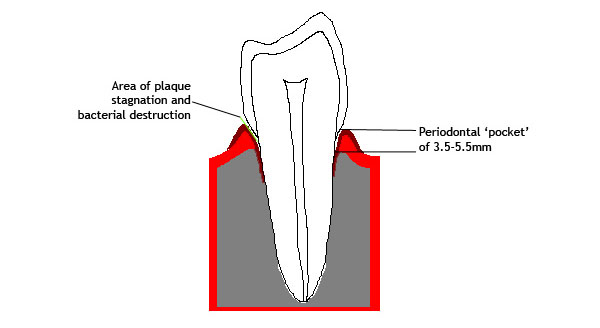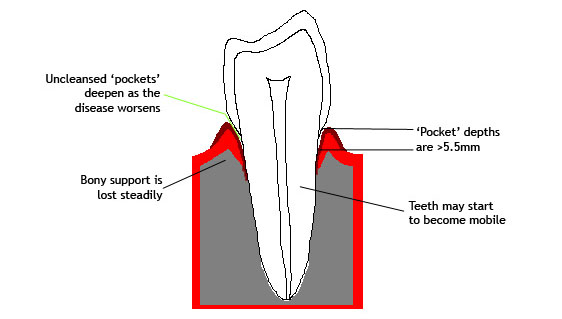Periodontal Diesase
Periodontal disease, also known as gum disease, is a common condition that affects the tissues supporting your teeth. It begins with inflammation of the gums and, if left untreated, can progress to affect the bone and connective tissue that hold teeth in place. Often painless in its early stages, it can quietly lead to tooth loss and other health complications if not addressed
In gingivitis, the gums gets inflamed and swells. They will be sore to touch, and may bleed easily. At this stage, healing occurs simply if the patient brushes more thoroughly. The gums presents ‘false’ pockets of >2mm, as the depth of the healthy pocket is increased only because the gum is bigger, not because of bacterial destruction.
These pockets are colonised by bacteria which relase their own toxins thus making the periodontal fibres loose and weak, leading to further shrinkage of the gums and the bone that supports the teeth. Periodontal disease may not be painful except in end-stage disease, where the teeth start getting mobile and painful to bite on.
In initial periodontal disease, plaque stagnates in the ‘false’ pockets which become a safe haven for bacteria. Bacterial toxins infiltrate the gum and cause destruction of the gum next to the tooth margin.
At a later stage as the gums shrink back further, bone destruction occurs, thereby reducing the structural support for the tooth. Pockets deepen, and mobility may set in.
It is therefore quite a dangerous disease as it may go un-noticed by the patient for a number of years and may be diagnosed casually on a routine dental check-up when it might be too late to treat in certain cases. It is therefore important to visit the dentist regularly, even if there is no obvious cause for concern or any symptoms, and have a scaling done regularly to remove all calculus from the teeth, which might be a factor that promotes periodontal disease.
Periodontal Disease Progression
-

The Healthy Gum
Healthy bone and gum around a tooth, the gum only 'pockets' about 2mm
-

Gingivitis
In gingivitis, the gums gets inflamed and swells. They will be sore to touch, and may bleed easily. At this stage, healing occurs simply if the patient brushes more thoroughly. The gums presents 'false' pockets of >2mm, as the depth of the healthy pocket is increased only because the gum is bigger, not because of bacterial destruction. These pockets are colonised by bacteria which relase their own toxins thus making the periodontal fibres loose and weak, leading to further shrinkage of the gums and the bone that supports the teeth. Periodontal disease may not be painful except in end-stage disease, where the teeth start getting mobile and painful to bite on.
-

Initial Periodontal Disease
In initial periodontal disease, plaque stagnates in the 'false' pockets which become a safe haven for bacteria. Bacterial toxins infiltrate the gum and cause destruction of the gum next to the tooth margin.
-

Established Periodontal Disease
At a later stage as the gums shrink back further, bone destruction occurs, thereby reducing the structural support for the tooth. Pockets deepen, and mobility may set in.
Is it posible to treat gum disease?
When diagnosed early enough, periodontal disease can be treated successfully and the disease stopped, although any bone or gum loss that may have occurred might not be reversed.
Following initial gum therapy and coupled with regular pocket cleansing, healing starts with the reduction of inflammation in the gums, followed by a reduction in pocket depth and consequently, cessation of bone destruction.
Healing is complete when gum inflammation and swelling go down completely, and pocket depth returns to the normal 2-3mm, thereby making the gum margins cleansable again. Some bone healing may occur, although bone regeneration does not usually occur unaided. Bone and gum grafts may be required to restore aesthetics in sensitive areas.
Any signs of bleeding from the gums must be followed up by more careful brushing at that particular spot, as that implies that the gums will have been irritated by the presence of plaque which causes gingival inflammation, which in turn if left unchecked might lead to periodontal disease. Smoking plays a big part in periodontal disease, not least as the bacteria that cause the disease thrive in an atmosphere of reduced oxygen. People with poorly-controlled diabetes are also at an increased risk. Your dentist might recommend seeing a specialist if periodontal disease is especially severe.
Periodontal Disease – Healing
-

Initial Healing
Following initial gum therapy and coupled with regular pocket cleansing, healing starts with the reduction of inflammation in the gums, followed by a reduction in pocket depth and consequently, cessation of bone destruction.
-

Stable Resolution
Healing is complete when gum inflammation and swelling go down completely, and pocket depth returns to the normal 2-3mm, thereby making the gum margins cleansable again. Some bone healing may occur, although bone regeneration does not usually occur unaided. Bone and gum grafts may be required to restore aesthetics in sensitive areas.
